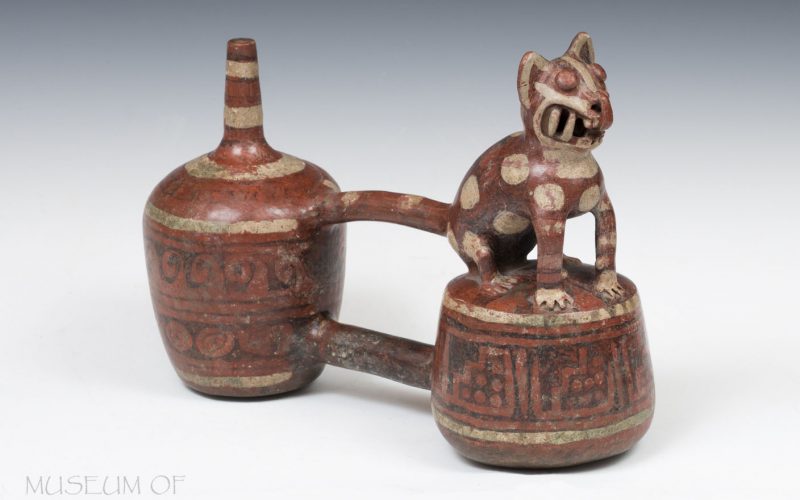Acquisitions expand MONAH narrative
BECCA MARTIN-BROWN
bmartin@nwadg.com
David Bogle, founder of the Museum of Native American History in Bentonville, didn’t intend to cover the spectrum from Cherokee to Pre-Columbian. He didn’t even intend to start a museum.
Bogle’s interest was born when he was a youngster, he says, “when Boy Scouts was the most important thing in my life.” Through scouting, he learned Native American “history and lore” to add to what he knew of his Cherokee heritage. He purchased his first collection of arrowheads from his Cub Scout master, he admits — but adds that was only 12 or 15 years ago.

Courtesy Photo
Jama-coaque warrior figure from Equador holds a macuahuitl (wooden club with obsidian blades inserted into it) in front. It dates in the 500 B.C. to 500 A.D. range. (1500-2500 years old) and measures 23 inches tall by 10 3/4 inches wide.
“It was kind of one of those snowballs,” he told What’s Up! in 2015. “The more it rolls, the bigger it gets.”
The museum, which started life in Bogle’s home, now covers the story of the Native American peoples from the Paleo Period — complete with the skeleton of a woolly mammoth — to the historic period from 1650 to 1900.
“When we opened in our location where we are now in 2008, I was a lot more concerned about telling a story of 14,000 years,” he says now, “and in order to tell that story we add artifacts when they make that story easier to understand. We’re also constantly building and changing displays so if you’re here today and come back next fall, you’ll have a different experience, see new pieces. That’s just how our museum grows.”
Bogle’s museum filled another gap in its narrative last month with the purchase of 10 artifacts from the Pre-Columbian period.
“We were looking for high quality Mayan and Meso-American items to enhance our collection. We knew that they were coming up for sale and had been watching in anticipation,” says MONAH curator Matt Rowe. “While there are a lot of artifacts for sale, it’s hard finding good quality examples that are authentic.”
Asked where the artifacts fit into the museum’s collection, Rowe explains.
“The museum covers the 14,000 year history (prehistory) of the Americas, not just North America. The Meso-America cultures down south were some of the most advanced and artistic anywhere in the world, not only the Americas, and are a very important part of our story.
“Meso-America is a cultural area in the mid-latitude of the Americas where many pre-Columbian societies prevailed before the Spaniard colonization in the 15th and 16th centuries,” Rowe goes on. “Many of these cultures were very advanced, some built highly sophisticated cities, had complex mathematical and astronomical systems.The Maya were some of the best-known of these cultures and occupied the Central American continent, including the southern parts of Mexico, Belize, Guatemala, El Salvador and the Honduras. They were very advanced and had the only fully developed pre-Columbian (before Columbus) written language system. They developed a calendar system that is so accurate that some people still use it today.”
Rowe enumerates the 10 pieces, beginning with “a dual-chambered ‘whistling’ jaguar effigy vessel from Peru.”

Courtesy Photo
Mayan polychrome tri-legged cylinder with three-dimensional howler monkey heads “shouldering the day” includes feathered serpent glyphs on top and bottom as well as two feathered shields. Legs have intricate checker design, and there are three images on the bottom which depict monkey hindquarters. From the Ulua Valley in Honduras, it measures 8-by-9 3/4 inches and dates in the 560-900 A.D. range.
“The ‘whistling’ pot was a very pleasant surprise,” he says. “It shows just how advanced they were artistically, as well as having a firm grasp on physics.”
Also acquired were two Pataky style polychrome vessels from Costa Rica, a large Aztec/Mazapan idol “that’s pretty neat,” and six of the recent acquisitions are Maya polychrome cylinders, two of them with monkey effigies, all from Central America.
Rowe wouldn’t reveal the cost of the artifacts beyond “a substantial amount,” but “it’s worth every penny to ensure that our collection is not only the best, but 100 percent authentic.”
“We’ve had some wonderful donations,” Bogle says, “but every single day we look for things to acquire. It’s much more rare to find something. Maybe only half a dozen pieces a year fit exactly what we need to make our story easier to understand.”
FAQ
Museum of Native American History
WHEN — 9 a.m.-5 p.m. Monday-Saturday
WHERE — 202 SW O St. in Bentonville
COST — Free
INFO — 273-2456; monah.us

Courtesy Photo
Pataky polycrome “footed” urn, left, is from the Nicoya/Guanacaste area of Costa Rica. This vessel features jaguar images at base and human facial features around the body. The red around the mouth represents facial hair. It measures 13 1/4-by-7 1/4 inches, circa 1000-1500 A.D. Pataky style vessel from Nicoya, Costa Rica, right, is a tri-leg effigy vase with extensive artwork and design. The composite effigy includes human arms and an avian face, and legs are adorned with harpy eagle heads. The artwork on the front of this vessel depicts a human skull and bones. Measuring 13 3/4-by-9 inches, it dates in the 1000-1500 A.D. range.



